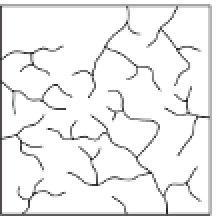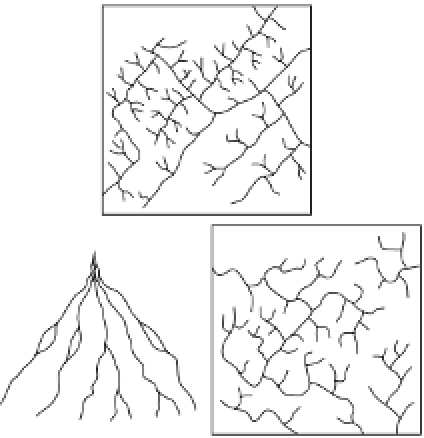Geology Reference
In-Depth Information
by irregular stream courses with short tributaries, lakes,
and swamps. Figure 5.17 shows the major types of
drainage pattern and their relationship to structural
controls:
and secondary tributaries run parallel to the main
streams. It is associated with alternating bands of
hard and soft dipping or folded beds or recently
deposited and aligned glacial debris. Fold mountains
tend to have trellis drainage patterns. An example is
the Appalachian Mountains, USA, where alternating
weak and strong strata have been truncated by stream
erosion.
4
Radial drainage
has streams flowing outwards in all
directions from a central elevated tract. It is found
on topographic domes, such as volcanic cones and
other sorts of isolated conical hills. On a large scale,
radial drainage networks form on rifted continental
margins over mantle plumes, which create litho-
spheric domes (Cox 1989; Kent 1991). A postulated
Deccan plume beneath India caused the growth of a
topographic dome, the eastern half of which is now
gone (Figure 5.18a). Most of the rivers rise close
to the west coast and drain eastwards into the Bay
of Bengal, except those in the north, which drain
north-eastwards into the Ganges, and a few that
flow westwards or south-westwards (possibly along
failed rift arms). Mantle plumes beneath southern
Brazil and southern Africa would account for many
features of the drainage patterns in those regions
(Figure 5.18b-c).
1
Dendritic drainage
has a spreading, tree-like pat-
tern with an irregular branching of tributaries in
many directions and at almost any angle. It occurs
mostly on horizontal and uniformly resistant strata
and unconsolidated sediments and on homogeneous
igneous rocks where there are no structural controls.
Pinnate drainage, which is associated with very steep
slopes, is a special dendritic pattern wherein the trib-
utaries are more or less parallel and join the main
stream at acute angles.
2
Parallel drainage
displays regularly spaced and
more or less parallel main streams with tributaries
joining at acute angles. Parallel dip streams domi-
nate the pattern. It develops where strata are uni-
formly resistant and the regional slope is marked,
or where there is strong structural control exerted
by a series of closely spaced faults, monoclines, or
isoclines.
3
Trellis drainage
has a dominant drainage direction
with a secondary direction parallel to it, so that pri-
mary tributaries join main streams at right angles
( ) Dendritic
a
( ) Parallel
b
()Trellis
c
( ) Radial
d
()Centrifugal
e
()Centripetal
f
( ) Distributary
g
( ) Rectangular
h
()Annular
i
Figure 5.17
Drainage patterns controlled by structure or slope.
Source:
Mainly after Twidale and Campbell (1993, 342) and adapted from Twidale (2004, 173)





